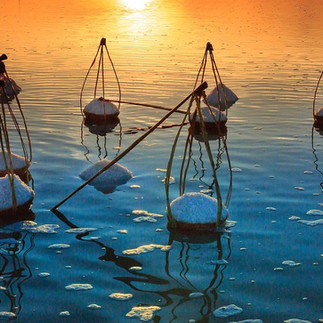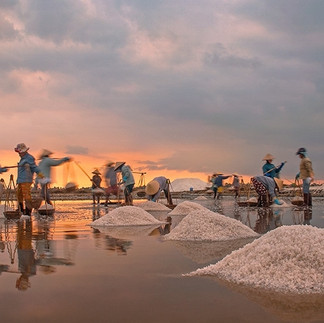Hon Khoi peninsula, near Nha Trang, has one of the largest swathes of Salt Fields, in the world, and it produces a third of all Vietnam's salt. Mounds of natural salt are manually harvested from shallow fields of 400 hectares, along Doc Let Beach, an hour’s drive from Nha Trang. With a coastline stretching as far as 3,260km, Vietnam produces 737,000 tons of salt annually, exporting 25,000 tons to countries like Japan and the United States.
Associating with the name Hon Khoi is the salt works that have nourished many generations of this land. The Hon Khoi Salt Fields are popular spots for photography,, and is renowned as a landscape with “white snow in summer”, where you can capture great views of the salt mountains and workers carrying heavy baskets across the fields.
Early morning and late afternoon are ideal times for photography snap shots!

The best time to visit Hon Khoi Salt Fields are between the months of January and June, when the summer climate (with temperatures that can go as high as 40°C) allows for the salt to be directed from the East Sea to the fields. It is then left there to evaporate for about 10 days before it is collected in wicker baskets, each weighing up to 10 kilogrammes.
Best Time to Go:
Collectively, the period between April and June is considered as the best time to obtain high quality salt since it is the most scorching hot at that time.

Making salt is a very difficult and hard work. It requires strength, perseverance and working hard. The salt workers (also known as the salt makers) must be in good health and withstand high pressure. The uniqueness of the Hon Khoi Salt Fields is that this strenuous salt-carrying task is only executed by middle-aged women and this activity takes place between 04:00 and 09:00 daily. To protect themselves from the heat and salt, these salt workers wear conical hats, rubber gloves and boots, as well as facemasks. While conditions are harsh during these months during this hot season, they are very resilient, approachable and friendly.

The name, Hon Khoi dates back to the 18th century when the the remaining army of the Ming Dynasty in China (who did not yield to the Qing Dynasty) sailed on the sea to the south in order to re-settle in Vietnam. Some wealthy people with more favorable conditions could reach the southern part of Vietnam, while some others wandered the sea and eventually became pirates. Sometimes, these so-called Chinese pirates came to loot offshore islands and coastal villages.
Given this situation, the Nguyen Dynasty of Vietnam commanded that the villagers had to set fire on the mountain peak so that the smoke could be seen and the locals would come to their rescue, whenever the pirates appeared to plunder and pillage.
Henceforth, this area was then named Hon Khoi, which literally means "Isle of Smoke".

How To Get There:
Hon Khoi Salt Fields in Ninh Hoa District is about 40 kilometers from Nha Trang City, so you can travel by car, taxi and motorbike. From Nha Trang City, you follow Highway 1C then Highway 1A to reach Ninh Diem Ward of Ninh Hoa District. There you turn right to get to Hon Khoi Salt Fields. It takes you about 1 hour and 10 minutes to go by car or taxi and 1.5 hour to go by motorbike to reach Hon Khoi Salt Fields.
The weather in Hon Khoi is relatively hot all time of the day, so one should prepare an umbrella or large-brim hat, long-sleeve shirt, sunscreen and water. You should not visit Hon Khoi Salt Fields at mid-day because the weather at that time is extremely hot. If you want to experience the salt-making activities of the locals, feel free to ask for their permission.

Doc Let Beach is a striking location to finish your day trip to Ninh Hoa, and some specialties that you should try when coming to Hon Khoi, as well as Ninh Hoa, are grilled meat roll, fish noodles, Lua salads and many other kinds of seafoods.
Handmade Vietnamese salt is also used for medical and chemical purposes in Korea; such an Amazing Discovery!

















Comments